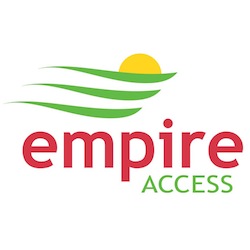
Fast, affordable Internet access for all.

Erie County, New York, and its county seat of Buffalo have had high-quality Internet access on their minds for several years. Now, County Executive Mark Poloncarz proposes a project to deploy middle mile infrastructure to attract local ISPs and generate competition. We're pleased to see county leadership taking another shot at better connectivity for the people in Erie County, but we hope community leaders will approach the project realistically; in order to bring high-quality Internet access to everyone, the county may need to play a more significant role in the future.
A Lingering Problem, A Possible Solution
Even though it's the county seat, a 2015 report from Erie County's Municipal Broadband Committee noted that the Buffalo Metropolitan Area's peak speeds ranked 294th in the state and that areas existed where there was no option for Internet access of ANY kind. The results horrified elected officials at the time; they issued a Request for Proposals (RFP) to study the feasibility of a county-wide publicly owned broadband network.
After a survey of residents and businesses, and an assessment of the current situation in Erie County, the final feasibility study recommended several actions, including a middle mile open access network investment. You can review the entire 2017 feasibility study here.
Problems with lackluster and even nonexistent Internet access have lingered in Buffalo and Erie County throughout the past two years. Community leaders have considered the feasibility study and given providers Verizon, Spectrum, AT&T, CenturyLink, and others operating in the region the chance to improve services to the entire county.
Now, County Executive Mark Poloncarz has announced that enough is enough and the digital divide won't narrow unless the public takes control. Taking the recommendation of the 2017 feasibility study to heart, Poloncarz has announced that he'd like Erie County to invest approximately $20 million in an open access middle mile network to connect community anchor institutions (CAIs), public facilities, and businesses interested in leasing dark fiber connectivity. The fiber infrastructure would also be open to private sector Internet access companies who want to extend last mile connections to households and businesses. The proposed project has been praised, criticized, and viewed with skepticism.
Prevent Cherry Picking
 We're pleased to see Erie County taking action. Investing in middle mile infrastructure and relying on private sector ISPs to build out the last mile always includes some risk, but the bigger risk for a community such as Erie County would be choosing to do nothing. It's apparent large corporate Internet access companies don't see any reason to connect households where people struggle to connect, either because rates are too high, or because sparse populations don't encourage deployment. Areas where fast, affordable, reliable connectivity is not available will not enjoy the same economic development as other regions.
We're pleased to see Erie County taking action. Investing in middle mile infrastructure and relying on private sector ISPs to build out the last mile always includes some risk, but the bigger risk for a community such as Erie County would be choosing to do nothing. It's apparent large corporate Internet access companies don't see any reason to connect households where people struggle to connect, either because rates are too high, or because sparse populations don't encourage deployment. Areas where fast, affordable, reliable connectivity is not available will not enjoy the same economic development as other regions.
One of the main objectives of the projects is to encourage expansion of broadband, especially to areas in the county that are hard to reach, are more rural, and that are considered lower-income. We are concerned that investment focused on middle mile investment will enable cherry picking in easier to serve and wealthier areas in Erie County, rather than deployment of last mile connections in the areas where households and businesses need broadband the most. Erie County will need to establish a plan on how best to prevent such an outcome.
If one or two more firms build those last mile connections in the more attractive areas, it isn't likely that another company will find motivation in deploying to poorly served and lower income areas because it will be harder to break into the market in the attractive areas. The nature of middle mile infrastructure projects make it more difficult to ensure that every one is able to connect to high-quality Internet access. County officials should address the potential for cherry picking and understand that they may require future investment toward connecting lower income areas to meet their goal of shrinking the digital divide.
Keep Expectations Realistic
People living in Erie County are frustrated, reporting poor services and lack of choice of Internet access providers; they hope that an open access network will bring more competition. The ErieNet plan aims to encourage local providers to deploy last mile connections needed to offer services. While middle mile networks lower the cost of investment for ISPs, deploying that last mile is still substantial. If the county were able to connect homes and businesses directly to the network, they would improve chances of attracting private sector investment. Expanding the project to connect premises would, of course, increase the cost of the project.
County officials estimate that the 360-mile project will cost approximately $20 million to deploy with a completion goal of 2021. Balancing a community's ability to invest in a project with the expected benefits is a fine line that every community leader must reconcile. Local people are best suited to know what their needs are and how much a community can invest to meet their needs.
 Erie County's middle mile network will probably lead to one or two more providers who want to deliver services via the new network, but will not produce the robust competition of Ammon, Idaho, or Utah’s UTOPIA Net. We expect to see a small number of new options in middle and upper income areas, but there's no guarantee that lower income or harder to serve areas will experience more choice or additional investment from private ISPs.
Erie County's middle mile network will probably lead to one or two more providers who want to deliver services via the new network, but will not produce the robust competition of Ammon, Idaho, or Utah’s UTOPIA Net. We expect to see a small number of new options in middle and upper income areas, but there's no guarantee that lower income or harder to serve areas will experience more choice or additional investment from private ISPs.
The extent of investment from the private sector and how long the expansion continues is unpredictable. We remain concerned that smaller local ISPs may eventually be sold to larger companies, such as Comcast or a similar corporate entity, and subscribers will be trapped taking service from a company with no desire to contribute to the well-being of the community.
On the Plus Side
Even if private sector investment doesn’t reach the level community leaders anticipate, even the hint of public investment in better connectivity often improves rates and services in a region. In Longmont, Colorado, incumbents Comcast and CenturyLink upgraded services to compete with the municipal network. National companies have the ability to lower rates to preserve their position in one region by raising rates in another area, as Charter (now Spectrum) did in Monticello, Minnesota, and as other large companies have in places like Denver and Chattanooga.
 With more than 300 miles of fiber within the county, the network could also make the region more attractive for fixed wireless and 5G investment. If Erie County makes dark fiber available to providers and keeps prices reasonable, companies offering the services are more likely to invest in the area because there will be more opportunities for antenna sites.
With more than 300 miles of fiber within the county, the network could also make the region more attractive for fixed wireless and 5G investment. If Erie County makes dark fiber available to providers and keeps prices reasonable, companies offering the services are more likely to invest in the area because there will be more opportunities for antenna sites.
New York’s Southern Tier Network has provided middle mile dark fiber infrastructure in several counties south and east of Erie County for a few years. ISP Empire Access has taken advantage of the opportunity to compete with incumbents in Corning and Elmira and may also see ErieNet as a chance to add subscribers. Jim Baase, CFO of Empire Access told the Buffalo News:
“Once Erie County builds out its network, we would contract with them to get around Erie County and then build out in the communities,” Baase said. “We would go into a community like the city of Buffalo and add fiber up and down virtually every street. It’s a large project.”
The ErieNet project could be a first step to publicly owned broadband in a major metropolitan area. With approximately 1.2 million people in the metropolitan area, and ongoing complaints about incumbents Spectrum and Verizon, people in and around the city are looking for options. Buffalo’s public power utility hasn’t taken up the prospect of offering Internet access to the community, but ErieNet may inspire other cities to take action.
Middle Mile Networks Have Good Things to Offer
While our Community Networks Map displays hundreds of places where publicly owned networks serve the community in one form or another, middle mile investments haven’t always met expectations. Connecting premises directly to a network creates a more attractive environment for ISPs considering operating over an open access infrastructure.
Nevertheless, places such as Martinsville in Virginia and Clackamus County, Oregon, offer middle mile connectivity that has resulted in economic development and better connectivity for businesses and residents. In Sandy, Oregon, the Clackamus County Broadband eXchange allowed the municipal network to obtain the low cost backhaul it needed to offer its $60 gig.
In A Nutshell
As Erie County moves forward with the ErieNet project, we encourage them to address the reality of cherry picking, expect that new competition will be limited, and prepare for future investment in order to connect premises hard to serve or in lower income areas.
For Poloncarz, other Erie County officials, and people living and working in the region, doing nothing isn't an option anymore. In March, he told the Buffalo News, " In the new Erie County, we're not leaving anybody behind."
Listen to Christopher discuss the project on WREN:
Image of Buffalo's Peace Bridge by Doug Kerr from Albany, NY, United States [CC BY-SA 2.0]
